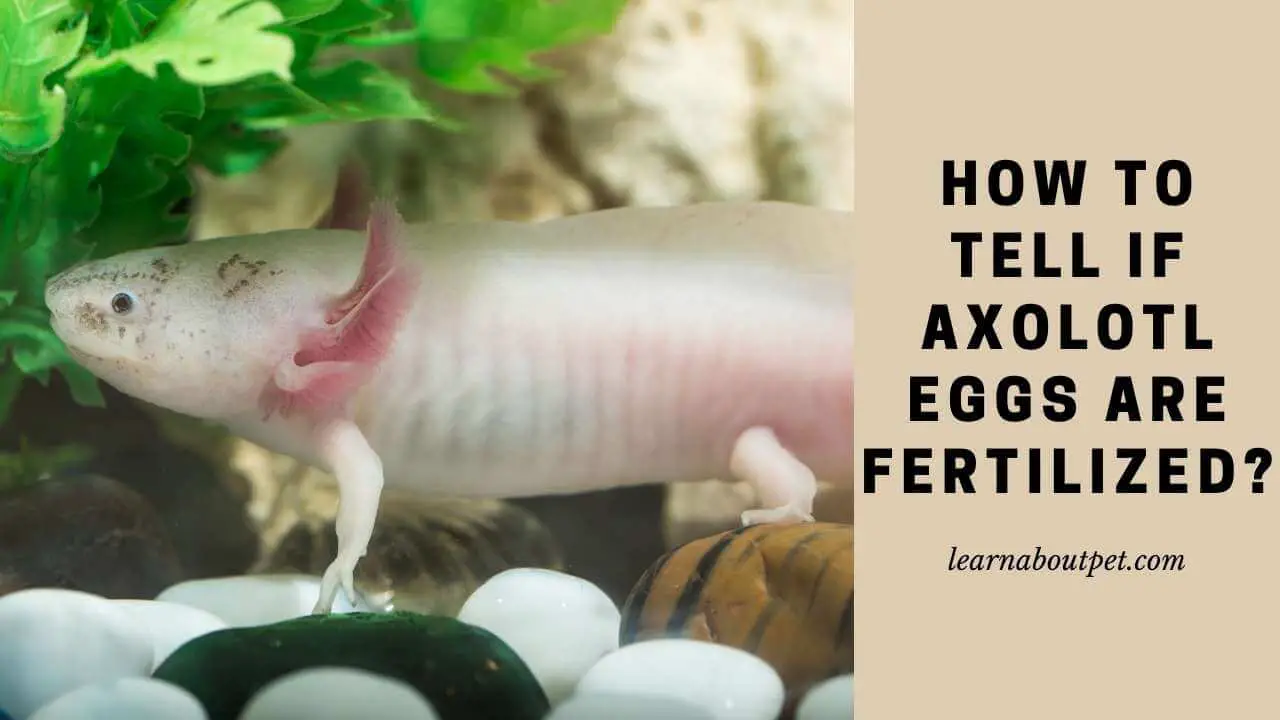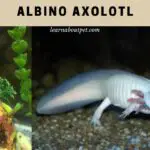Caring for exotic pets such as the axolotl is both challenging and exciting. If you want to increase the axolotl population to not become extinct, you can do breeding if allowed by the state where you live.
It’s not challenging to put axolotls with different genders for the mating process if both axolotls are already sexually active, especially if you’ve been waiting for the right age of 18 months so that the eggs have a higher chance of surviving.
But how to tell if axolotl eggs are fertilized? Let’s read this article to the end.

How Do I Know If My Axolotl Egg Is Fertilized?
The first step is to find out how to tell if axolotl eggs are fertilized or not. You can look at the size of the eggs and also the color.
Fertilized eggs will be more significant with an estimated 5x larger in diameter than unfertilized, then the color of the eggs is clearly between black or white with protection jelly around it.
For size estimation, unfertilized eggs are about 0.2 cm, and fertilized eggs are about 1.1 cm. You can clearly see the difference between the two because fertilized eggs are more clearly visible in terms of diameter.
What Do Fertilized Axolotl Eggs Look Like?
Next, when you want to know how to tell if axolotl eggs are fertilized, you need to know what it looks like. The fertilized eggs have a distinct jelly layer around the eggs.
The color of the eggs can be black or white, depending on the axolotl breed. Healthy axolotl eggs will slowly change and will darken in color over time. The black egg is produced from the regular axolotl, while the white egg is produced from the albino axolotl.
Make sure you don’t put the female axolotl in after the egg-laying process is complete because there is still a high chance that the adult axolotl will eat their eggs.
Can Axolotls Lay Unfertilized Eggs?
Female axolotls do not lay unfertilized eggs unless something extraordinary happens. How to tell if axolotl eggs are dead? Unfertilized eggs are smaller than fertilized eggs and occur more frequently if the female axolotl is younger than 18 months.
This is different from how to tell if axolotl eggs are fertilized because the female axolotl is still not old enough to breed, and there are many possibilities for them to produce unfertilized eggs.
Do Female Axolotls Lay Eggs Regardless Of Fertilization?
A female axolotl can’t lay eggs if it does not undergo the fertilization process. A male axolotl must be present to fertilize because the male axolotl will spread spermatophores around the tank. The female axolotl will approach to insert the sperm cap into their cloaca.
How to tell if axolotl eggs are fertilized? Female axolotls must be old enough to produce fertilized eggs with a minimum age of 18 months.
After the fertilization process, a few days later, the female axolotl will produce the eggs. This is when you need to move the male axolotl to spread their eggs around the tank without having an adult axolotl eat the eggs.
Do Female Axolotls Lay Unfertilized Eggs Regularly?
After female axolotls have entered sexual maturity at 12 months, they can already carry out the breeding process even though it is not perfect. If the female axolotl is still too young, between 12 months to 18 months, they most likely produce unfertilized eggs.
This will continue to be repeated every time axolotls breed until they are more than 18 months old or have done several breeding times so that for the second or third time, they will be much better at producing fertilized eggs than those that are not.
If female axolotls are of sufficient age, they are less likely to produce unfertilized eggs. How to tell if axolotl eggs are fertilized? The color is brighter, and the diameter is more significant.
Can Obviously Fertile Eggs Just Not Hatch?
If the fertile eggs don’t hatch, several things could happen. The most important thing is that the tank does not have the right temperature for the development of eggs, so the eggs do not hatch even though they are fertilized.
The humidity of the tank also affects the growth and development of eggs, so you have to check the humidity so that the development of eggs is perfect until the egg hatches.
Temperatures that are too high make eggs unable to develop because axolotls also cannot tolerate high temperatures above 22°C.
Keeping the tank clean, the proper temperature and the correct humidity are the keys to developing the embryo in the eggs until the hatching process is complete.
Axolotl eggs water change will also affect the temperature, so you have to be careful in regulating the water in the tank until the next 14 days or 30 days while the eggs are still developing.
What Color Are Fertilized Axolotl Eggs?
Fertilized eggs follow their parents. If you have a wild axolotl or another axolotl in addition to a white base, then their eggs tend to be black. While albino or axolotl with white offspring, most likely the eggs’ color is also white.
Black and white axolotl eggs are the exact sizes when fertilized, and the color will not change until the egg is hatched.
You will often see the eggs attached to plants in the tank or on the substrate. You can move the plant without breaking the eggs to another tank, so you can set the right temperature for egg development more efficiently.
What Color Are Unfertilized Axolotl Eggs?
Unfertilized axolotl eggs have a milky and cloudy color. The shape is swollen and not perfectly round. The eggs are getting darker and decaying. Also, you see that they are much smaller than the early fertilized eggs, and they will not progress to the later stages.
There are also unfertilized eggs that look fungi and mold, making it easier to distinguish from the fertilized ones. You need to separate the unfertilized eggs from those that are not, so you can better monitor those that can develop.
What Do I Do When My Axolotl Laid Eggs That Are Unfertile?
The eggs laid by the female axolotl are more often in the form of a big clump than scattered one by one. If you see unfertilized eggs stuck to the plant and separated from the rest, you can easily clean them.
But if you see unfertilized eggs in the big clump, don’t pick them up and leave them undeveloped because they won’t interfere with the development of other eggs.

How to tell if axolotl eggs are fertilized? They are larger in size and lighter in color between black and white. Unfertilized eggs are only 0.2cm in size and look very different from the others.
It doesn’t matter even if a female axolotl lays the unfertilized eggs. The percentage of breeding success is also seen from many factors such as parents’ age, humidity in the tank, water cleanliness, and suitable temperature.
Can You Move Axolotl Eggs Once They Are Fertilized?
It depends on the tank used for the female axolotl laying their eggs. If the axolotl spreads around the tank and sticks to several plants, and you can move the plants, you can move the eggs at once with the plants.
If the eggs are in the big clumps, then you need to move them slowly. As much as possible, do not hold the big clump eggs directly with your hands so as not to squeeze and damage the eggs in the middle.
This is one of the ways how to hatch axolotl eggs because it ensures that axolotl eggs will get proper handling until the hatching process is complete. How to tell if axolotl eggs are fertilized? You can tell in terms of diameter, and there is a jelly that protects the eggs from the outside.
How To Hatch Axolotl Eggs?
How to hatch axolotl eggs is how to care for them. Axolotls can lay their eggs up to 100 eggs or more, and you have to prepare a special tank so that the eggs can develop to hatch.
Axolotl eggs are better at 19-20°C. If it is lower than that, the embryo will also slow down its growth. If it is more than 22°C, the eggs will be moldy and dead or stop developing.
You have to observe axolotl eggs day by day, such as looking at the color of the eggs based on the offspring, watching the embryo move inside the eggs until the eggs hatch in about 14-30 days.
How to tell if axolotl eggs are fertilized? White or black in the middle of the jelly around the eggs, measuring up to 1.1cm and sticking to the substrate or plant leaves in the tank.
How Long Does It Take For Axolotl Eggs To Hatch?
Female axolotls take 12-72 hours to lay their eggs. After the axolotl is finished, you can move it to another tank so that the tank only contains axolotl eggs. Always control the temperature of the tank to reach 19-20°C.
If the temperature is right, axolotl eggs can take up to 14 days to hatch. But if the temperature rises and falls, the eggs can hatch longer, up to 30 days. This is also influenced by water quality. If the humidity is maintained, the embryo will also develop.
How to tell if axolotl eggs are fertilized? It has a black or white color, and there is a protective jelly around it. If you make observations and see the embryos crusting little by little, that’s a sign the eggs are developing well.
How Many Axolotl Eggs Survive In The Wild?
How many axolotl eggs survive in the wild is uncertain because adult axolotls can also eat eggs. If a female axolotl produces an estimated 200 eggs, only 30% or less will likely survive the hatching process.
Therefore, it requires human assistance for breeding so that breeding is by the age of the female axolotl, the fertilized eggs are larger, and the possibility of survivability is higher.
You can also see axolotl eggs in the game Minecraft. What does the axolotl eggs look like in Minecraft? It is pink with magenta spots, and players cannot craft this item.
How To Take Care Newly Hatched Axolotls?
After you know everything about how to tell if axolotl eggs are fertilized, you should also know the axolotl life stages and how to properly care for them. The table below will introduce you to some of the axolotl life stages.
| Life stages | Explanation |
| Egg stage | Take some time for the egg to grow after being placed by the female axolotl. |
| Embryo stage | The small embryo will form the axolotl body until the hatch process. |
| Larva stage | Two stage in larva, without legs until has 2 front legs. |
| Young adult stage | Rear legs have started to appear, and this stage the axolotl is already sexually active. |
| Adult stage | Able to live independently and capable of breeding. |
Final Verdict On How To Tell If Axolotl Eggs Are Fertilized
Having axolotls as aquatic pets will be very interesting if you also practice breeding to increase their population because they are critically endangered.

There are many things you should know so that the survivability of eggs is high in terms of water quality, suitable temperature, and an empty tank without adult axolotls. Learn more about the Haploidy and Triploidy induction research here.
For those of you who want to distinguish between fertilized eggs and unfertilized eggs, it can be seen from the shape and size. For fertilized eggs several times larger than unfertilized. The unfertilized color is more cloudy and looks like there is fungus and mold.
You can set the unfertilized eggs aside and let the fertilized eggs develop until they hatch. You need to take care of the baby axolotl to the adult stage by providing a proper meal, a temperature that is always maintained, and clean water at all times.

Welcome to Learn About Pet. My name is Rajkumar Ravichandran and I love all pets, travel, and amazing food. I write about my passion and personal experience caring for multiple pets in this blog! ❤️
Post Disclaimer
DISCLAIMER: THIS BLOG OR WEBSITE, "Learn About Pet", DOES NOT PROVIDE YOU WITH MEDICAL ADVICE AND IS NOT A SUBSTITUTE FOR MEDICAL ADVICE. ALWAYS GET IN TOUCH WITH YOUR PERSONAL VETERINARIAN AND USE INFORMATION HERE AS GENERAL ADVICE.
The information, including but not limited to, text, graphics, images and other material contained on this website are for informational purposes only. No material on this site is intended to be a substitute for professional veterinary advice, food recommendation, diagnosis, or treatment. Always seek the advice of your veterinarian or other qualified health care provider with any questions you may have regarding a medical condition or for pet food related questions.







